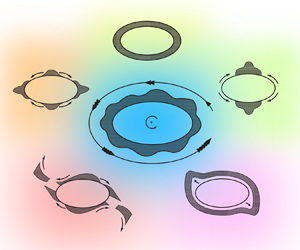Article contents
Granular flow on a rotating and gravitating elliptical body
Published online by Cambridge University Press: 14 April 2021
Abstract

We investigate two-dimensional shallow granular flows on a rotating and gravitating elliptical body. This is motivated by regolith flow on small planetary bodies – also called minor planets – which is influenced by the rotation of the body, as well as its irregular topography and complex gravity field. Governing equations are obtained in an elliptic coordinate system attached to the body by extending the framework employed for terrestrial avalanches to incorporate effects of rotation, varying gravity and a curvilinear surface. Additionally, we introduce criteria to monitor grain shedding and to track flow initiation and cessation. We delineate different types of regolith motion that are governed by the rotation rate and surface roughness of the body. We find that grains migrate towards the minor and major axis of the body at low and high rotation rates, respectively. Grains are shed when the basal pressure vanishes, and shedding is encouraged by Coriolis effects during prograde flow. We observe the coexistence of regions of static and mobile regolith and their reorganization owing to the merging or division of flows. We also probe the formation and destruction of dunes – bulges arising from local grain accumulation – and find several aspects of their motion to be different from terrestrial situations. We then perform discrete element simulations that display a good match with theoretical predictions. Finally, we consider the evolution of a bi-disperse regolith. We find that big and small grains occupy, respectively, the top and bottom of the dunes formed on the surface, which is reminiscent of observations on asteroids like Itokawa.
Information
- Type
- JFM Papers
- Information
- Copyright
- © The Author(s), 2021. Published by Cambridge University Press
References
REFERENCES
- 4
- Cited by


